Once upon a time there was a king in Hawai, he loved the joyful elements of life and thus he was called “The Merrie Monarch;” he traveled around the world, brought back Hula – the Polynesian dance, revived surfing, wrote “Hawaiʻi Ponoʻī,” which is the state song of Hawaii today and is credited with making the ukulele popular. Kalākaua born, David Laʻamea Kamananakapu Mahinulani Naloiaehuokalani Lumialani Kalākaua (we dare you to pronounce his name twice), was the last reigning king of the Kingdom of Hawaiʻi and this is his story.
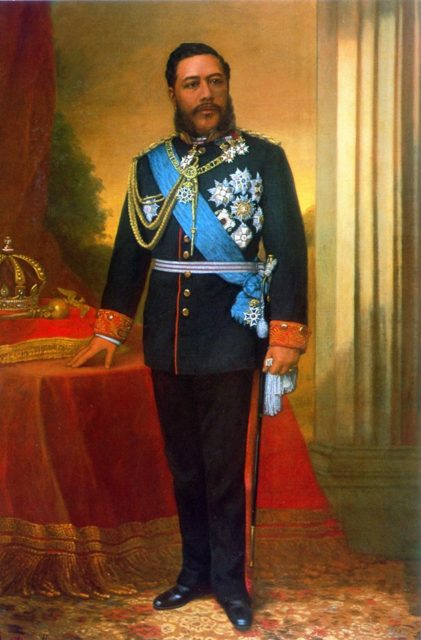
Official painting of King David Kalakaua by William Cogswell. Source:
Wikipedia /Public Domain
Kalākaua was the second surviving son of his father High Chief Caesar Kaluaiku Kapaʻakea and his mother High Chiefess Analea Keohokālole. He was the older brother of Moses, James Kaliokalani, Lydia Kamakaʻeha, Anna Kaʻiulani, Kaʻiminaʻauao, Kinini, Miriam Likelike, and William Pitt Leleiohoku II. His name Kalākaua translates into “The Day [of] Battle” and refers to the unequal treaty imposed by British Captain Lord Edward Russell of the Actaeon on Kamehameha III on the day of his birth. Although he was promised in hānai to Kuini Liliha, Kaʻahumanu II gave him to the High Chiefess Haʻaheo Kaniu and her husband Keaweamahi Kinimaka instead.
When Haʻaheo died in 1843 she bequeathed all her properties to him. His guardianship was entrusted in his hānai father, who was a chief of lesser rank; he took Kalākaua to live in Lāhainā. Kinimaka would later marry Pai, a subordinate Tahitian chiefess, who treated Kalākaua as her own until the birth of her own son.
At the age of four, Kalākaua returned to Oʻahu to live with his biological parents and to begin his education at the Chiefs’ Children’s School. At the school, Kalākaua became fluent in English and the Hawaiian language. He began studying law at the age of 16. His various government positions, however, prevented him from fully completing his legal training. Instead, by 1856, the young Hawaiian was a major on the staff of King Kamehameha IV. He had also led a political organization known as the Young Hawaiians; the group’s motto was “Hawaii for the Hawaiians.” In addition to his military duties, Kalākaua served in the Department of the Interior and, in 1863, was appointed postmaster general.
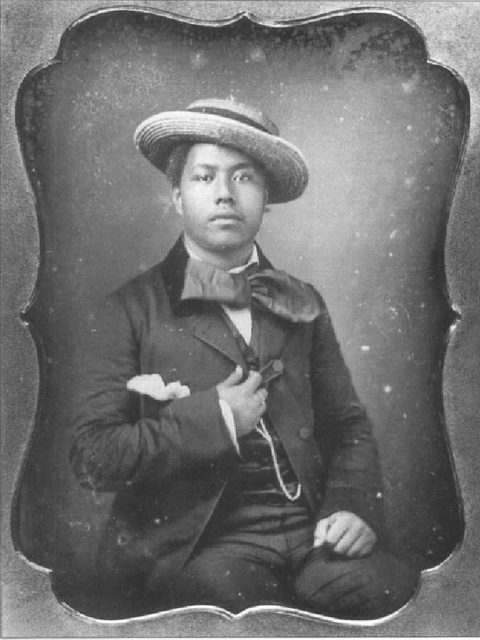
Kalākaua in his youth, c. 1850.Source:
Wikipedia /Public Domain
King Kamehameha V, the last monarch of the Kamehameha dynasty, died on December 12, 1872 without naming a successor to the throne. Under the kingdom’s constitution, if the king did not appoint a successor, a new king would be appointed by the legislature.
There were several candidates for the Hawaiian throne. However, the contest was centered on the two high-ranking aliʻi, or chiefs: William C. Lunalilo and Kalākaua. Lunalilo was more popular, partially because he was a higher-ranking chief than Kalākaua and was the immediate cousin of the Kamehameha V. Lunalilo was also the more liberal of the two — he promised to amend the constitution to give the people a greater voice in the government. Many believed that the government should simply declare Lunalilo as the king. Lunalilo, however, refused to allow this to be done and insisted that everyone in the kingdom should take part in an election for the office of the king.
Kalākaua published a proclamation written in a Hawaiian poetic style. Here is an excerpt:
“O my people! My countrymen of old! Arise! This is the voice!
Ho! all ye tribes! Ho! my own ancient people! The people who took hold and built up the Kingdom of Kamehameha. Arise! This is the voice. Let me direct you, my people! Do nothing contrary to the law or against the peace of the Kingdom. Do not go and vote. Do not be led by the foreigners; they had no part in our hardships, in gaining the country. Do not be led by their false teachings.”
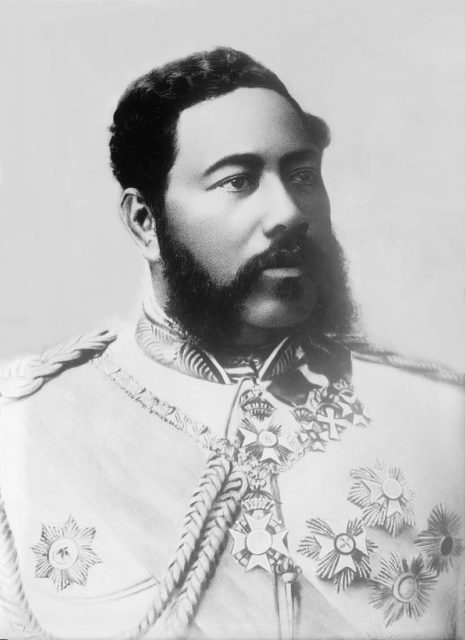 Portrait of Kalakaua Source Wikipedia Public Domain
Portrait of Kalakaua Source Wikipedia Public Domain
Kalākaua was much more conservative than his opponent, Lunalilo. At the time, foreigners dominated the Hawaiian government. Kalākaua promised to put native Hawaiians back into the kingdom’s government. He also promised to amend the kingdom’s constitution.
On January 1, 1873, a popular election was held for the office of King of Hawaii. Lunalilo won with an overwhelming majority. The next day, the legislature confirmed the popular vote and elected Lunalilo unanimously. Kalākaua conceded.
Continue to page 2
Lunalilo died on February 3, 1874, and Kalākaua was elected to replace him, supported by the legislature although many of the populace, mainly the native Hawaiian and British subjects in the kingdom, preferred Queen Dowager Emma, who stood against him. Upon ascending the throne, Kalākaua named his brother, William Pitt Leleiohoku, as his heir.
Kalākaua began his reign with a tour of the Hawaiian islands. This improved his popularity. In December 1874, Kalākaua sent representatives to the United States to negotiate a reciprocity treaty to help end a depression that was ongoing in Hawaiʻi. In November, Kalākaua traveled to Washington, D.C. to meet President Ulysses S. Grant. An agreement was reached and the treaty was signed on January 30, 1875. The treaty allowed certain Hawaiian goods, mainly sugar and rice, to be admitted into the United States tax-free.
In 1881, King Kalākaua left Hawaiʻi and became the first monarch in the world,to venture on a trip around the world to study the matter of immigration and to improve foreign relations. He also wanted to study how other rulers governed. In his absence, his sister and heir, Princess Liliʻuokalani, ruled as regent (Prince Leleiohoku, the former heir, had died in 1877). The king first traveled to San Francisco where he was given a royal welcome. Then he sailed to the Empire of Japan where he met with the Meiji Emperor. He continued through Qing Dynasty China, the Sultanate of Johore, Siam under King Chulalongkorn (Rama V), Burma, British Raj India, Egypt, Italy, Belgium, the German Empire, Austria-Hungary, the French Third Republic, Spain, Portugal, the United Kingdom of Great Britain and Ireland, and back through the United States before returning to Hawaiʻi.
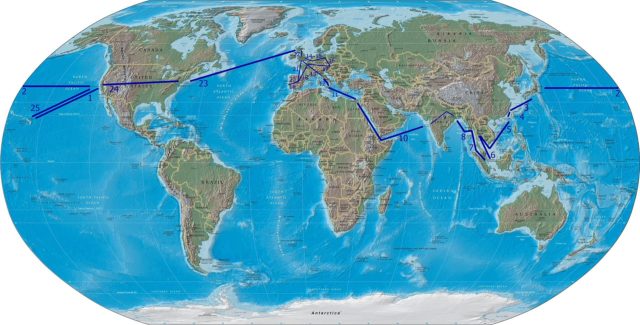
Journey of King Kalakaua in 1881By
© CC BY-SA Thomas Tunsch / Wikimedia Commons), CC BY-SA 3.0,
During this trip, he met with many other crowned heads of state, including Pope Leo XIII, Umberto I of Italy, Abu Bakar of Johor, Tewfik, Viceroy of Egypt, William I of Germany, Rama V of Siam, U.S. President Chester A. Arthur, and Queen Victoria. In this, he became the first king to travel around the world. William N. Armstrong, who was a member of the King’s Cabinet and accompanied His Majesty on the circumnavigation, documented the trip in Around the World With a King. In the Kingdom of Sweden he was presented with the Royal Order of Vasa, Grand Cross, on 18 February 1881 by King Oscar II.
Kalākaua also built ʻIolani Palace, the only royal palace that exists on American soil today, at a cost of $300,000—a sum unheard of at the time. Many of the furnishings in the palace were ordered by Kalākaua while he was in Europe.
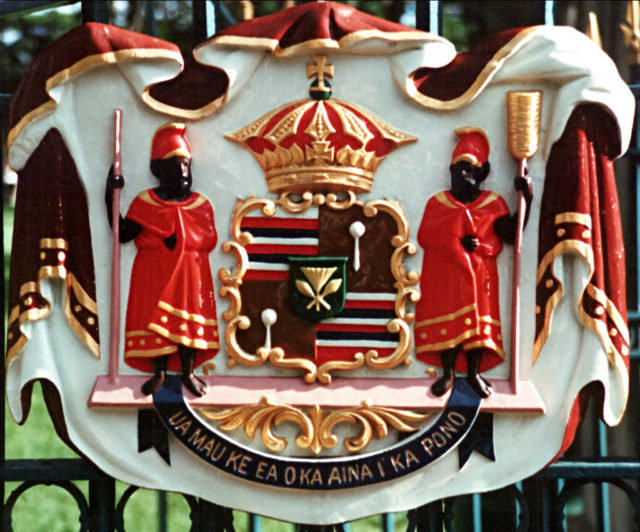
Coat of Arms of the Hawaiian Kingdom, ʻIolani palace, Honolulu, Hawaiʻi By
© CC BY-SA Thomas Tunsch / Hawaii kingdom COA.jpg (Wikimedia Commo...
Kalākaua decided to erect the Kamehameha Statue in recognition of Kamehameha I, the first king of the whole Hawaiian Islands. The original statue was lost when the ship carrying it sank near theFalkland Islands, so a replacement was ordered and unveiled by the king in 1883. The original statue was later salvaged, repaired and sent to Hawaii in 1912. A third statue was erected in 1969 and is currently the only statue in the United States Capitol that commemorates a native Hawaiian.
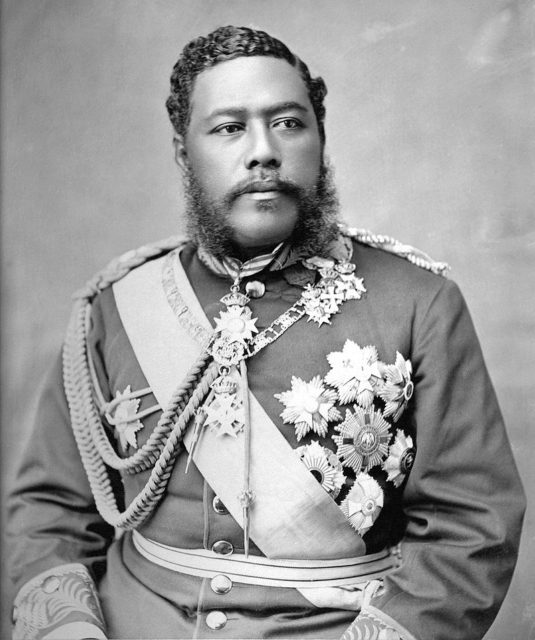
Hawai’i State Archives image of King David Kalakaua. Source:
Wikipedia /Public Domain
King Kalākaua is said to have wanted to build a Polynesian Empire. In 1886, legislature granted the government $30,000 ($790,000 today) for the formation of a Polynesian confederation. The king sent representatives to Sāmoa, where Malietoa Laupepa agreed to a confederation between the two kingdoms. This confederation did not last very long, however, since King Kalākaua lost power the next year to the Bayonet Constitution, and thus a reformist party came into power that ended the alliance.
By 1887, the Missionary party had grown very frustrated with Kalākaua. They blamed him for the kingdom’s growing debt and accused him of being a spendthrift. Some foreigners wanted to force King Kalākaua to abdicate and put his sister Liliʻuokalani onto the throne, while others wanted to end the monarchy altogether and annex the islands to the United States. The people who favored annexation formed a group called the Hawaiian League. In 1887, members of the league, armed with guns, assembled together. The members of the league forced him at gunpoint to sign the new constitution.
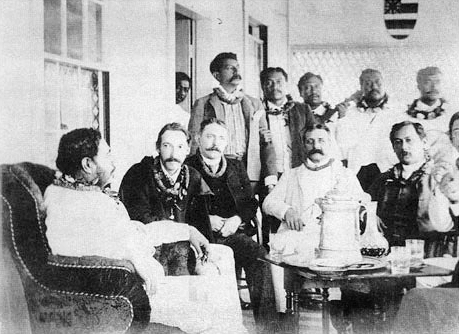
King Kalākaua, Scottish writer Robert Louis Stevenson, and Kalākaua’s Singing Boys , his own personal headed choir, c. 1889 Source
Wikipedia Public Domain
This new constitution, nicknamed the Bayonet Constitution of 1887, removed much of the king’s executive power and deprived most native Hawaiians of their voting rights. 75% of ethnic Hawaiians could not vote at all, because of the gender, literacy, property, and age requirements.
With the new requirements, ethnic Hawaiians now amounted to about two-thirds of the electorate for representatives and about one-third of the electorate for Nobles. The rest of the voters were male residents of European or American ancestry.
While historically voting rights were not granted to all citizens in the kingdom, not unlike other countries at the time, the new constitution served to greatly disenfranchise the native Hawaiians and consolidated a major power shift. It even inserted a provision that allowed non-Hawaiian citizens to vote. Moreover, the legislature was now able to override a veto by the king, and the king was no longer allowed to take action without approval of the cabinet. The House of Nobles, the house of legislature appointed by the king, was to be elected.
 Official painting of King David Kalakaua by William Cogswell. Source:Wikipedia /Public Domain
Official painting of King David Kalakaua by William Cogswell. Source:Wikipedia /Public Domain Kalākaua in his youth, c. 1850.Source:Wikipedia /Public Domain
Kalākaua in his youth, c. 1850.Source:Wikipedia /Public DomainPortrait of Kalakaua Source Wikipedia Public Domain

 Journey of King Kalakaua in 1881By
Journey of King Kalakaua in 1881By Coat of Arms of the Hawaiian Kingdom, ʻIolani palace, Honolulu, Hawaiʻi By
Coat of Arms of the Hawaiian Kingdom, ʻIolani palace, Honolulu, Hawaiʻi By Hawai’i State Archives image of King David Kalakaua. Source:
Hawai’i State Archives image of King David Kalakaua. Source: King Kalākaua, Scottish writer Robert Louis Stevenson, and Kalākaua’s Singing Boys , his own personal headed choir, c. 1889 Source
King Kalākaua, Scottish writer Robert Louis Stevenson, and Kalākaua’s Singing Boys , his own personal headed choir, c. 1889 Source 












Pentru a putea adăuga comentarii trebuie să fii membru al altmarius !
Alătură-te reţelei altmarius